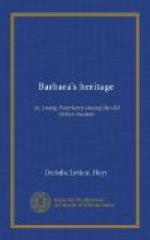By and by they turned their attention to the Madonna di Foligno, and were especially interested in it as being a votive picture. Margery, who was very fond of this Madonna, with the exquisite background of angels’ heads, had a photograph of it in her own room at home, and knew the whole story of the origin of the picture. So she told it at Malcom’s request, her delicate fingers clasping and unclasping each other, according to her habit, as she talked.
“How true it is that one ought to know the reason why a picture is painted, all about its painter, and a thousand other things, in order to appreciate it properly,” said Malcom, as they turned to leave the room.
“That is so,” replied his uncle. “I really feel,” with an apologetic smile, “that I can do nothing with Raphael. There is so much of him scattered about everywhere. We will regard this morning’s study as only preliminary, and you must study his pictures by yourselves, wherever you find them. By the way,” and he turned to look back through the doorway, “you must not forget to come here again to see Domenichino’s great picture. How striking it is! But we must not mix his work with Raphael’s.”
They passed through the first room of the gallery, stopping but a moment to see two or three comparatively unimportant pictures painted by Raphael, and went out into the Loggia.
“I brought you through this without a word, when we first came,” said Mr. Sumner. “But now I wish you to look up at the roof-paintings. They were designed by Raphael, but painted by his pupils. You see they all have Bible subjects. For this reason this Loggia is sometimes called ‘Raphael’s Bible.’ The composition of every picture is simple, and in the master’s happiest style.”
As they left the Loggia and entered “Raphael’s Stanze,” a series of rooms whose walls are covered with his frescoes, Mr. Sumner said:—
“We will to-day only give a glance at the paintings in this first room. They are, as you see, illustrative of great events in the history of Rome. They were executed wholly by Raphael’s pupils, after his designs.”
“I shall come here again,” said Malcom, in a positive tone. “This is more in my line than Madonnas,” and he made a bit of a wry face.
“And better still is to come for you,” returned his uncle with a smile, as they passed on. “Here in this next room are scenes in the religious history of the city, and here,” as they entered the third room, “is the famous Camera della Segnatura.”
“Room of the Signatures! Why so called?” asked Barbara.
“Because the Papal indulgences used to be signed here; and here,” continued Mr. Sumner, turning for a moment toward Malcom, “are the greatest of all Raphael’s frescoes. We will now stop here for a few minutes, and you must come again for real study. The subjects are the representations of the most lofty occupations that engage the minds of men—Philosophy, Justice, Theology, and Poetry. This is the first painting done by Raphael in the Vatican, and it is all his own work, both design and execution.




